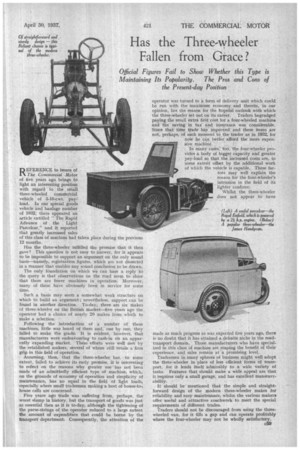Has the Three-wheeler Fallen from Grace?
Page 117

If you've noticed an error in this article please click here to report it so we can fix it.
Official Figures Fail to Show Whether this Type is Maintaining Its Popularity, The Pros and Cons of the Present-day Position
REFERENCE to issues of The Corninercial Motor of five years ago brings to light an interesting position with regard to the small three-wheeled comraercial vehicle of 3-10-cwt. payload. In our special goods vehicle and haulage number of 1932, there appeared an article entitled "The Rapid Advance of the Light Parcelear," and it reported that greatly increased sales of this class of machine had taken place during the previous 12 months.
Has the three-wheeler fulfilled the promise that it then gave? This question is not •easy to answer, for it appears to be impossible to support an argument on the only sound basis—namely, registration figures, which are not dissected in a manner that enables any sound conclusion to be drawn.
The only foundation on which we can base a reply to the query is that observations on the road seem to show that there are fewer machines in operation. Moreover, many of these have obviously been in service for some time.
Such a basis may seem. a somewhat weak structure on which to build an argument ; nevertheless, support can be found in another direction. To-clay, there are six makes of three-wheeler on the British market—five years ago the operator had a choice of nearly 20 makes from which to make a selection.
Following the introduction of a number of these machines, little was heard of them and, one by one, they failed to make the grade. It is evident, however, that manufacturers were endeavouring to cash-in on an apparently expanding market. These efforts were well met by the established makers, several of whom still retain a firm grip in this field of operation.
• Assuming, then, that the three-wheeler has, to some extent, failed to achieve its early promise, it is interesting to reflect on the reasons why greater use has not been made of an admittedly efficient type of machine, which, on the grounds of economy of operation and simplicity of maintenance, has no equal in the field of light loads, especially where small tradesmen making a host of house-tohouse calls are concerned.
Five years ago trade was suffering from, perhaps, the worst slump in history, but the transport of goods was just as essential then as it is to-day, although the tightening of the purse-strings of the operator reduced to a large extent the amount of expenditure that could be borne by the transport department Consequently, the attention of the
operator was turned to a form of delivery unit which could be run with the maximum economy and therein, in our opinion, lies the reason for the hopeful outlook with which the three-wheeler Set out on its career. Traders begrudged paying the small extra first cost for a four-wheeled machine and the saving in taxand insurance was considerable. Since that time trade has improved and these items are not, perhaps, of such moment to the trader as in 1932, for now he can better afford the more expensive machine.
In many cases; too, the four-wheeler provides a body of bigger capacity and greater pay-load so that the increased costs are, to some extent offset by the additional work of which the vehicle is capable. These factors may well explain the reason for the four-wheeler's intrusion in the field of its lighter confrere.
Whilst the three-wheeler • does not appear to have made as much progress as was expected five years ago, there is no doubt that it has attained a definite niche in the roadtransport domain. Those manufacturers who have specialized in this class of machine are reaping the benefit of their experience, and sales remain at a promising level.
Tradesmen in many spheres of business might well adopt the three-wheeler in place of less efficient forms of transport, for it lends itself admirably to a wide variety of tasks. Features that should make a wide appeal are that it requires only a small garage, and has excellent rnanceuvra bility.
It should be mentioned that the simple and straightforward design of the modern . three-wheeler makes for reliability and easy maintenance, whilst the various makers offer useful and attractive coachwork to meet the special requirements of different trades.
Traders should not be discouraged from using the threewheeled van, for it fills a gap and can operate profitably where the four-wheeler may not be wholly satisfactory,








































































































































































